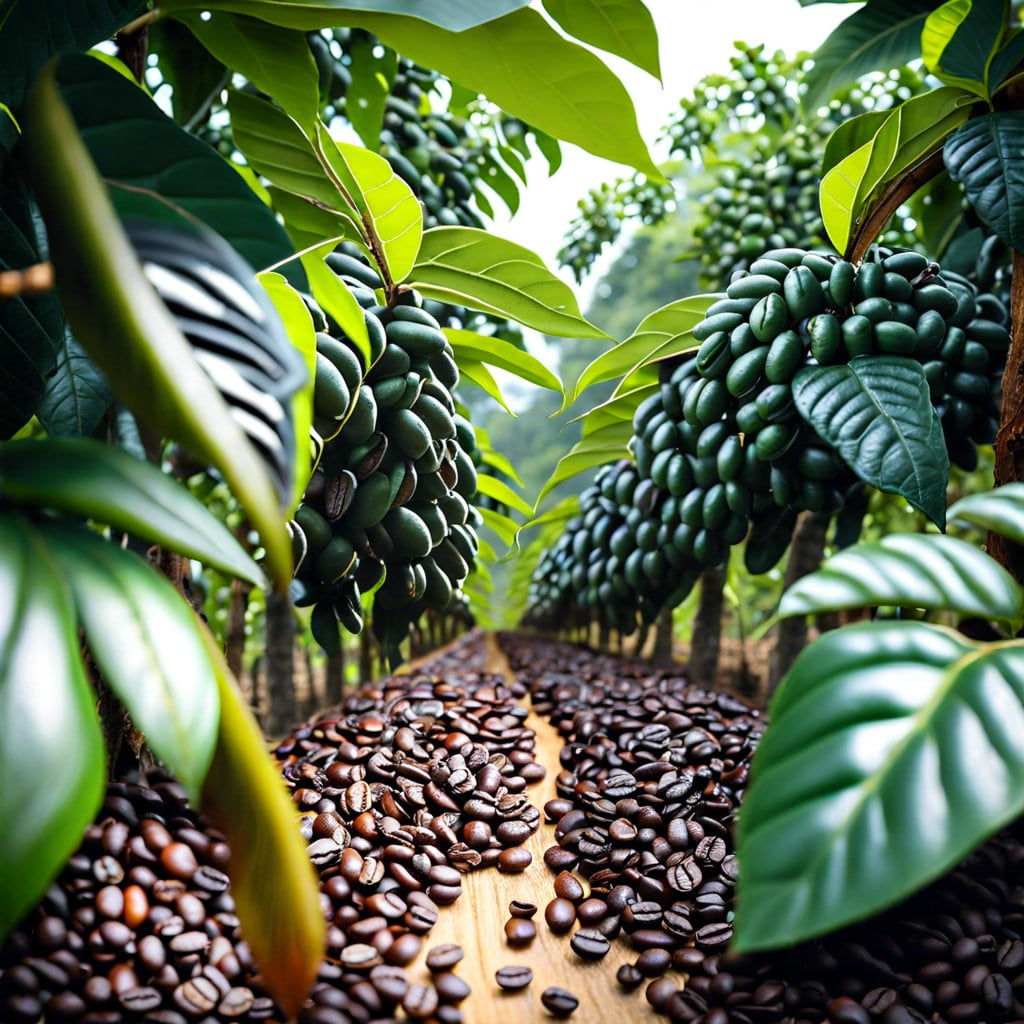Discover the diverse climates and regions where coffee beans thrive, from mountainous altitudes to tropical conditions.
The Bean Belt

Straddling the equator, an invisible strip encircles the globe, acclaimed for its prime coffee-growing conditions. This is the Bean Belt, stretching between the Tropics of Cancer and Capricorn. Warm temperatures, abundant rainfall, and lofty altitudes in this zone offer the ideal nurturing ground for coffee plants. Countries that fall within this swath are recognized as some of the world’s prominent coffee producers.
Crucial to coffee cultivation is not just the location but also the climate. The Bean Belt’s environments are diverse, providing a range of microclimates which contribute to the distinct flavors of the beans. Volcanic soil, for example, is a common feature and is celebrated for imparting a special touch to the coffee grown in these fertile terrains.
Coffee enthusiasts would find that the world’s favorite morning brew owes much to this geographical phenomenon. Indeed, the conditions within the Bean Belt allow for the cultivation of those magic beans that eventually make their way into cups across the globe.
Central and South America Coffee Regions
Brazil takes the crown for volume, being the largest producer worldwide. Its vast plantations focus mainly on bulk commodity beans. Yet, there’s more than quantity; Brazilian coffee offers hints of chocolate and nuts, perfect for espresso lovers seeking a smooth experience.
Colombia, synonymous with quality, prides itself on its rich arabica, celebrated for its mild, fruity profile. The Andean mountains provide an ideal climate, giving Colombian beans their signature taste.
Costa Rica’s volcanic soil and meticulous processing techniques birth beans with a reputation for balance and brightness, often featuring crisp apple and berry notes.
Guatemala’s diverse microclimates yield a wide taste spectrum. From the smooth sweetness of Antigua to the spicy kick of Huehuetenango, this nation caters to a palette of preferences.
What binds these regions together? Altitude. High elevations slow bean development, embedding complexity and a desirable acidity that coffee aficionados cherish. Here, geography is taste.
Africa and the Middle East Coffee Production
Stepping into the African continent, Ethiopia takes center stage as the birthplace of coffee. The country’s distinct coffee exhibits notes often described as wine-like, with a floral aroma that coffee connoisseurs celebrate. The Harrar, Sidamo, and Yirgacheffe regions each contribute a symphony of flavors unique to their soils and climates.
Continuing the journey, Kenya’s high-altitude farms, coupled with a meticulous processing method, yield beans that are richly acidic and fruity. The Kenyan AA is a sought-after grade known for its clarity and full-bodied flavor.
Crossing over to Tanzania, the slopes of Mount Kilimanjaro shelter coffee trees that gift us with beans characterized by a bright acidity and medium body, often with hints of berry and citrus.
The Middle East shouldn’t be overlooked, with Yemen’s history intertwined deeply with coffee culture – cultivating in the terraced mountainsides, Yemeni coffee presents a complex, rich and, at times, spicy cup.
This part of the world offers a diverse palette of flavors, each shaped by the varied microclimates and traditional processing methods that coffee farmers have honed over centuries.
Coffee Bean Varieties
Arabica and Robusta are the headliners in the coffee bean ensemble, each boasting distinct characteristics. Arabica, akin to a delicate wine, thrives at higher elevations and seduces with complex flavors and a softer profile. Robusta, meanwhile, packs a punch with its bolder, more assertive taste and a caffeine content that doesn’t shy away from a challenge.
Dig a bit deeper and you’ll also meet Heirloom varieties—Ethiopia’s gift to coffee diversity with flavors as varied as a spice bazaar. Then there’s the Bourbon and Typica—aristocrats of the coffee lineage, treasured for their refined quality and the taste they gracefully bestow upon a brew.
But let’s not overlook the newcomers—hybrids like the Catimor or SL28 that are like the maverick fusion chefs of the coffee world, blending resilience to harsh conditions with taste profiles that keep the coffee connoisseurs buzzing.
Each variety is a story, a journey through altitude, climate, and soil—a symphony of factors conjuring the magic that ends up in your cup. Remember, the variety is merely the starting point; it’s the barista who brings the narrative to life.
What Impacts the Quality and Flavor of Coffee?
Soil composition exerts a major influence on coffee’s personality. Minerals, pH level, and drainage properties shape a bean’s ultimate flavor profile.
Altitude matters; higher elevations often yield beans with higher acidity and a more nuanced taste.
Climate plays a defining role as well. Coffee cherishes a balance of sun and rain, with temperature swings threatening its development.
Harvesting can’t be rushed. Pick them too early or too late and the bean’s flavor can suffer.
Processing method—washed, honey, or natural—adds its own spin. Each technique imprints the bean with distinct flavors and textures.
Roasting is the alchemy of coffee. Light, medium, or dark, the roaster’s craft is pivotal in coaxing out the bean’s song.
Finally, freshness is non-negotiable. Like a whispered secret, a bean’s flavor is most vibrant when young and deteriorates with time.
These elements work in concert to produce the symphonies of flavor savored in every cup.